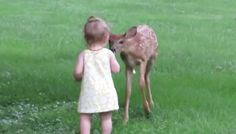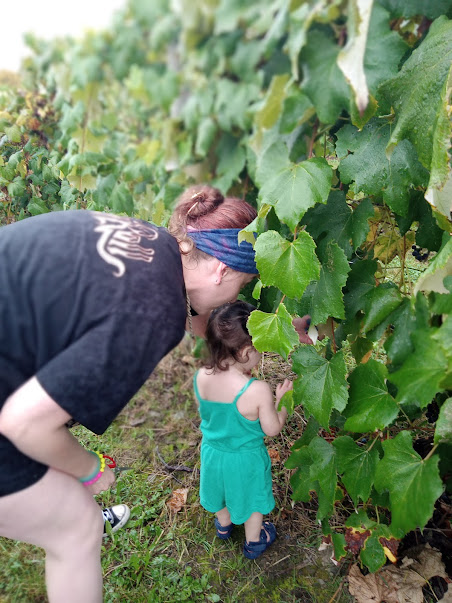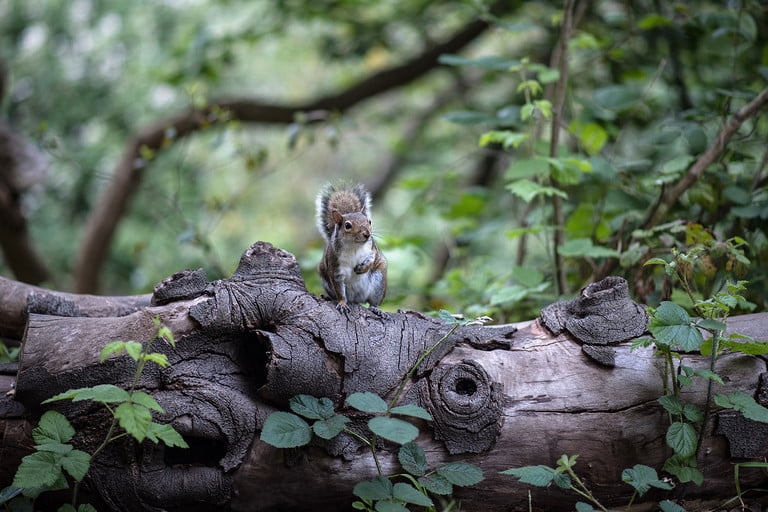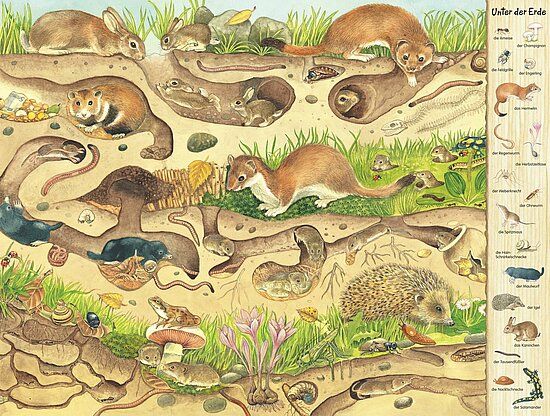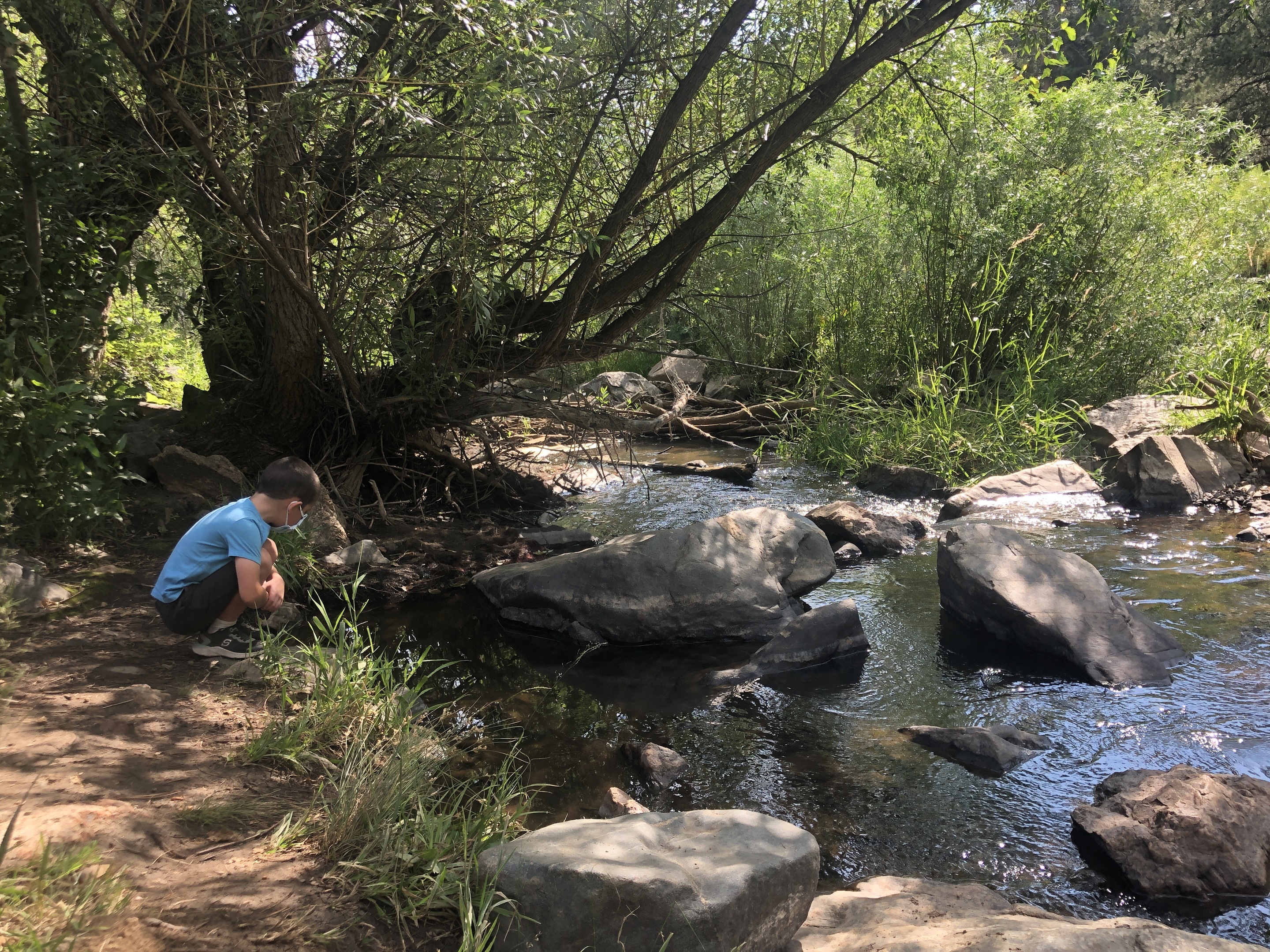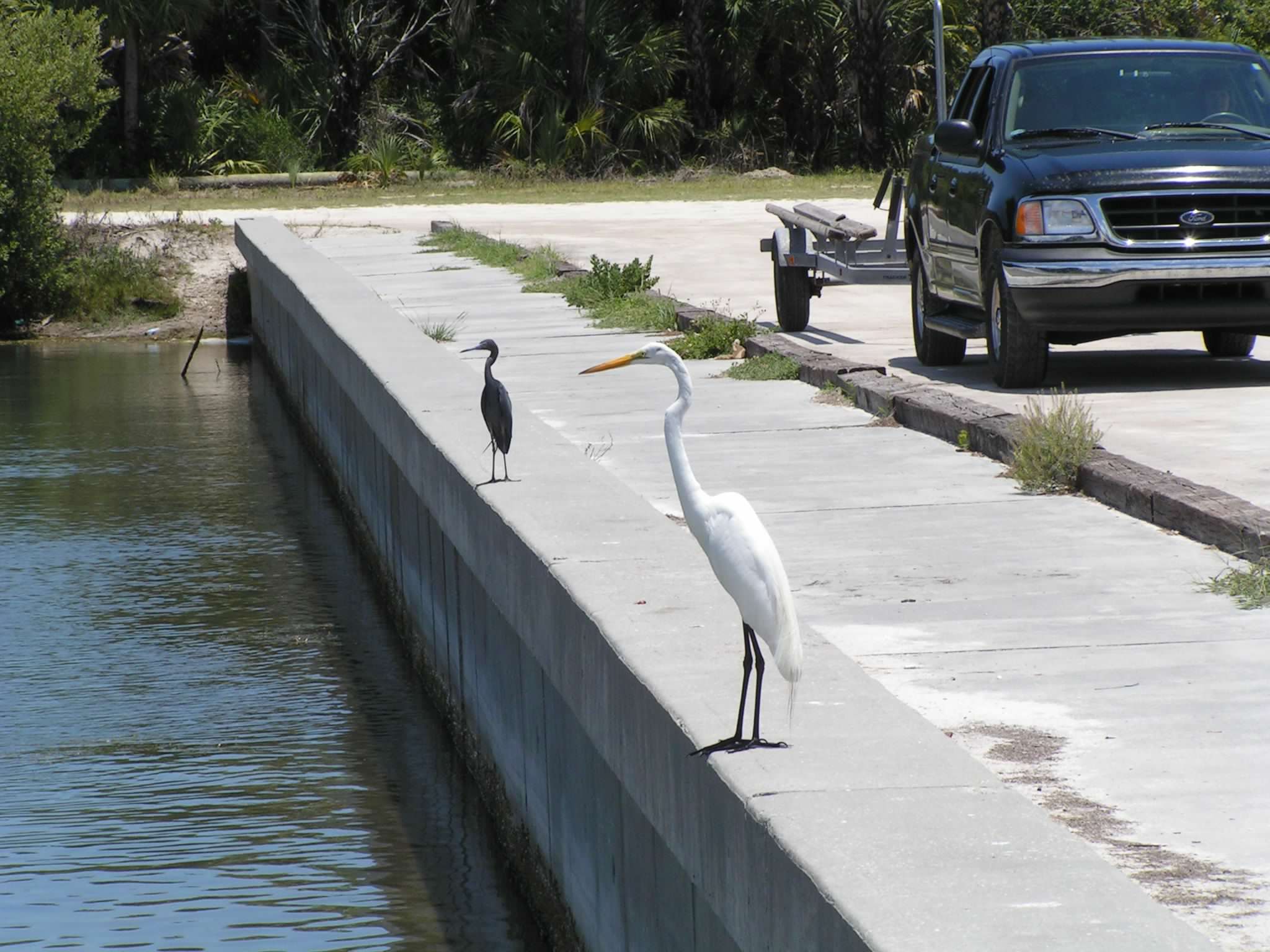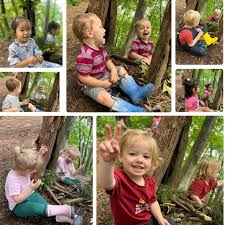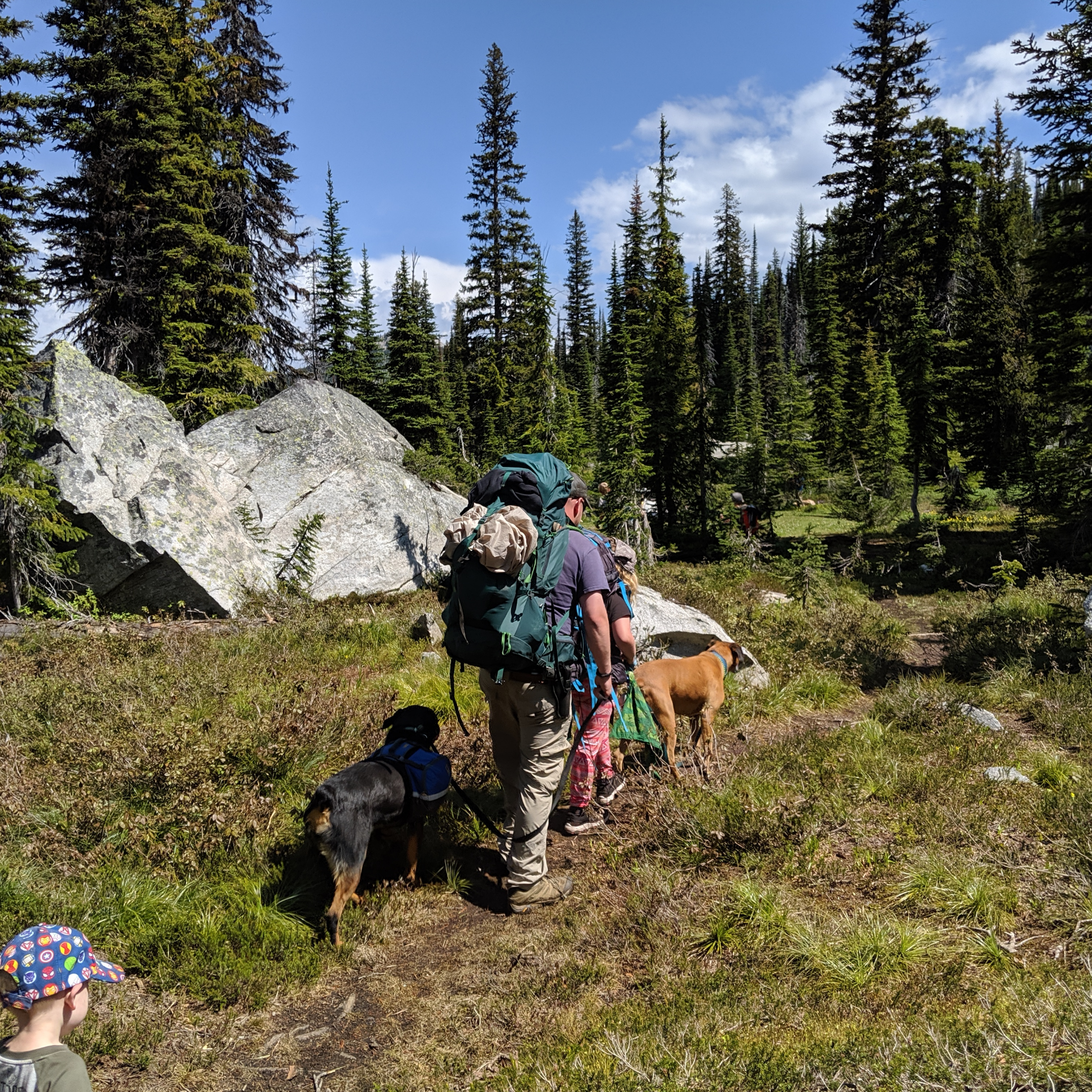Superscript
Introducing Wildlife
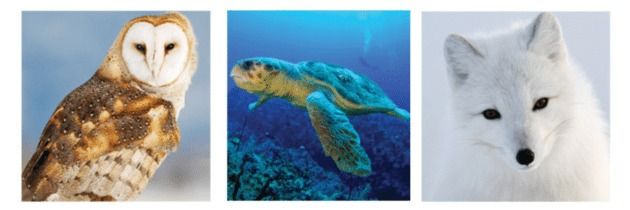
You can help babies learn about wildlife by engaging them through authentic hands-on experiences like nature walks, visiting zoos, and setting up bird feeders . Other methods include reading wildlife books, singing animal songs, watching nature shows, and using animal-themed activities and games for pretend play.
Go on nature walks: Explore local parks and nature centers. Encourage your baby to observe small creatures, look for different types of birds, and listen to the sounds of nature. Create a wildlife-friendly yard: Install a bird feeder or birdhouse to attract birds and other small creatures for your baby to observe. Visit zoos and farms: Take your baby to a zoo, aquarium, or farm to see a variety of animals up close. Discuss the animals' habitats and behaviors to spark curiosity.
Read and sing: Use wildlife-themed books and songs to introduce animal names, sounds, and behaviors. Use toys and games: Incorporate stuffed animals for pretend play, like feeding and caring for them, and use animal flashcards or games to learn about different species. Watch nature shows: Watch nature documentaries together to expose your baby to different animals in their natural environments. Talk about what you see and ask questions to encourage further thought.
Model gentle behavior: Show your baby how to be gentle and compassionate, even with insects. If you must handle one, catch and release it instead of killing it. Plant for pollinators: Plant flowers that attract bees and butterflies to give your baby the joy of watching these creatures at work. Teach about conservation: When your child is older, discuss why it's important to protect animal habitats and what can be done to help. Encourage gentle handling: I f you have a pet, involve your baby in its care to teach them how to be gentle and responsible.
Spend time outdoors : Take frequent walks in a park, backyard, or green space, even if it’s just a stroller walk. Laying a blanket under a tree or letting them explore grass can be a great start, say Reddit users. Create nature rituals: Develop routines like refilling bird feeders or watering plants, and talk about the birds or insects that visit, suggests The Morton Arboretum . Start a wildlife garden: Plant native flowers, shrubs, and trees to create a habitat for local wildlife. You can also plant herbs and vegetables to attract pollinators, according to the National Wildlife Federation .
Point out wildlife: Gently show your baby flowers, leaves, or even insects. Let them feel the texture of a leaf or a stick. Bring nature in: Collect natural items like interesting leaves, pinecones, or smooth stones and let your baby explore them. Use tools for discovery: For older babies, a magnifying glass can help them observe small creatures more closely, explains National Geographic . Ask questions: Encourage curiosity by asking questions like, "What does that bird's feather look like?" or "What sound does that cricket make?".
Model kindness: Show your baby how to be gentle with animals by using soft, quiet movements yourself. When they get rough, gently guide their hands and say "soft" or "gentle," says a Quora user . Talk about animals: Talk about what you see and hear, and teach them about how different animals live and their roles in the environment. Focus on the positive: Instead of focusing on what to avoid, highlight what they can see and hear, like the chattering of birds or the busy work of ants. Teach gentle rules: Teach them not to squish insects, as they may not realize the consequences of their actions.
Nurturing Your Children's Love for Animals
Honoring a Biological Connection
A simple experience such as this one may seem cute or charming, (and indeed, it is!) but there’s so much more going on here than meets the eye. Most folks who work with children know that children are drawn to animals of all kinds. There is definitely something special about children’s interest in animals. Research shows that humans’ innate interest in animals is biological: we are drawn to species that are “other” than human and in many cases have an instinct to want to care for or nurture creatures that are small and vulnerable.
Photo by Patty Born Selly
In 1984 E.O. Wilson, a biologist, introduced the idea of “biophilia”-that innate affinity we humans have for other living things. In recent years, many early educators have recognized this affinity in young children and have embraced a philosophy that includes lots of living natural materials in the classroom (such as plants and flowers), nature-based play areas with landscape features that include lots of vegetation, and providing plenty of outdoor time for children.
Children can truly thrive when allowed extended periods of time in natural settings that are full of life. A “biocentric” approach to early care and education means more than just providing opportunities for nature play however. It can—and should—include opportunities for children to connect with living animals.
Unlike adults who tend to value animals for what they can provide (food, leather, wool), or how they can serve us (as companions), children tend to value animals simply because they are. They recognize the intrinsic value of animals—that simply because they are living creatures, they are important.
Observing Wild Animals
Children can bond with household pets, residents at a petting zoo, classroom pets, and even the neighborhood cat who’s always roaming the block. These creatures can spark a lifelong love of animals in young children, but encounters with wild animals can be extra-special.
Photo by Dani Porter Born
When children have opportunities to see wildlife, a whole new world of wonder can open up. And the animals needn’t be large or exotic: even common wild creatures such as ducks, squirrels, and backyard birds will bring a thrill to children. Seeing wild animals in nature can become a child’s treasured memory. Wild animals have certain qualities that make them mysterious and exciting to children. Their homes are different from ours, and are built by the animals themselves. Wild animals have to find their own food, and they eat “weird things” like bugs and worms. They have special powers like flying, digging, and climbing (which children often fantasize about), and the animals themselves choose when and where to be seen by children, not the other way around.
Building Connection, Empathy, and Stewardship
When children are outdoors and are visited by an animal, such as the ducks in the example above, or when they enter an animal’s space (nature) they feel lucky. It’s as if they’ve been invited into a special world. Bringing a child to a wild place, a wooded park or even just a schoolyard, where there are opportunities to encourage wildlife sightings or other kinds of connections, can help children develop that innate love for animals. An added benefit? A growing body of research shows that children who are supported in their love for animals tend to generalize that love to other living things, such as plants and nature. Research also shows that when children are encouraged to care for animals, they tend to be more sensitive and caring toward other people as well. So by supporting children’s love for animals, you’re helping nurture those all-important feelings of connection and stewardship as well.
Photo by Patty Born Selly
Many educators are concerned that children will yell, chase animals, or even squash bugs. It’s true that children will likely do all of these things! It’s normal, part of how children are learning to play with their own power and explore vulnerability. The truth is, children are doing these things to learn. They want to know “what happens if I……” and the best way to find out is to try it. When they see the effects of their behavior on animals, children learn about their own capabilities and the impacts that they have. For example, if Dionne chases the family of ducks, the children will learn that the ducks will scramble away. Just remember to approach behavior management as positively as possible.
Supporting children in their growing awareness and interest in animals can lead to deeper feelings of empathy in young children, more positive classroom relationships, and social-emotional development. As children have experiences with animals, they learn about differences and similarities, needs (such as for food, shelter, water and space), and compassion and empathy can grow and deepen.
Practical Ideas for Early Care and Education Settings
How can you support children’s love for animals? Early care and education settings are prime opportunities to nurture curiosity about wildlife. Consider these ideas:
Set up a bird feeding area outside your classroom window or in another location where the children will be able to view the birds. (Note, many seed mixes contain peanuts, a common allergen. Take precautions if there are allergic children in your care.)
Venture outside often! As mentioned, the sight of a common squirrel or even a trail of ants on a sidewalk can be exciting and special. If you do come across wildlife, allow the children to observe and share their discoveries. Encourage their questions and conversations.
Encourage (but don’t force) quiet observation. Most of the animals you’ll likely encounter (squirrels, insects, birds) are accustomed to humans, so often they won’t be too afraid of noisy, excited children. If children’s outbursts do frighten the animals away, just use that as an opportunity to make a scientific observation about the effects of noise on animals. As you know, it’s awfully hard for young children to stay silent when they are excited and surprised!
Be matter of fact about a “no squishing bugs” rule (if you have one, and I hope you do) rather than shaming children for squishing a bug. Often children simply don’t expect to kill insects when they step on them, and children can be quite upset to learn that the bug has died.
Look and listen for evidence of animals every time you are outdoors. You may see tracks, nests, or other signs of animals. You may hear birds chattering in the cold winter morning. Allow the children to point out their observations and the “clues” that wildlife is everywhere.
Encourage children to think about “what it’s like to be that duck” (or squirrel, or ant….). This invitation to imagine not only builds vocabulary and language skills, but it also helps children develop the habit of perspective-taking, which is another term for empathy.
If you have a classroom pet, encourage children to participate in caring for the animal. Feeding, changing water, and even decorating an animal’s cage or tank can be important ways for young children to take responsibility for the care of a living, vulnerable creature, and develop confidence in themselves and their abilities as well. (Note: Children should always wash hands after handling animals or animal care items.)
Early care and education professionals have great opportunities to use nature as a setting to learn more about animals, foster curiosity, and nurture children’s innate feelings of love and concern for wild creatures. These skills and feelings are more important today than ever!
List of 30+ Animals and Their Homes
How To Understand Habitats
“No matter who you are or where you are, instinct tells you to go home.”- Laura Marney.
After a long day at school or work, we feel an urge to return to our safe place, our home. Animals are no different in this respect. They too return to their homes after spending their day wandering here and there. But what do animal homes look like? How do animals create their homes?
In this article, we have curated a long list of animals and their homes names. But before we walk you through the list, let us tell you why animals need home.
Animal shelters or homes:
Where do animals live?
Just like we need a place to cover ourselves and feel safe, animals also need a space to cover and protect themselves. Homes not only protect animals from predators, harsh weather conditions, and other dangers but also offer them a place to rest and raise the young ones.
Some animals live in their natural habitat and call it home, while some animals create their homes. While wild animals are always responsible for finding and creating their shelters, domestic animals get lucky because humans create homes for them.
Animal Homes: Why do they need them?
Animals need homes for various reasons. The following reflect the same:
To protect themselves
Animals constantly need to protect themselves and their young ones from predators, harsh weather conditions, such as rain, thunder, cold, and heat, and other dangers lurking around them.
To keep their food safely
Animals often look for a safe place to store their food for easy access, which is why they need homes.
To take rest
Animals need a place to rest, sleep, and take respite in harsh environmental conditions.
To reproduce and raise their babies
A home provides animals with a safe and secure place to lay eggs and raise their young ones.
List of animals and their homes names
Different animals have different homes that suit their needs, survival strategies, instincts, and the environment they live in. As already mentioned, some animals, mostly wild animals, live in a large space, a habitat, while some animals make their homes themselves. Domestic animals often live in their owners’ homes or special homes made by them.
Here we have created a list of animals and their home names:
Wild animals and their homes
Wild animals inhabit nature. They live in forests, deserts, mountains, and oceans. While some wild animals construct their homes, some live carefree in their natural habitat. Here we have listed some wild animals and their homes.
1. Lion live in Den
The king of the jungle, the Lion, lives in dens. Lions often return to their dens, which could be caves, bushes, or large trees, and to rest between their hunting sprees. They protect their cubs in dens.
2. Tiger live in Cave
Tigers seek homes in dense forests or caves. They hide in their caves during adverse conditions and use thick bushes to hide and stalk their prey.
3. Bear live in Cave or Den
The home of bears is called a cave or a den. They live in their caves during hibernation and extreme cold to protect themselves from predators.
4. Polar Bears live in Ice Dens
Polar Bears live in the Arctic regions in caves or ice dens. They spend their days on sea ice and live inside ice dens or caves to protect themselves from freezing winds.
5. Deer live in Forest
Deer inhabit forests or grasslands. They tuck away behind tall grass when they see any predator.
6. Elephant live in Forest
Elephants do not build their homes. They live in open spaces or under large trees in forests.
7. Fox live in Burrow
Foxes live in burrows or dens. They dig their burrows to protect their young, store food, and rest.
8. Snake live in Burrow or Hole
Snakes often live in burrows or holes dug by other animals. They spend time in the comfort of burrows during extreme weather conditions and when they want to keep themselves safe from predators.
9. Monkey live on trees
Monkeys protect themselves from ground predators by living on trees. They also find their food and rest on trees.
10. Bird live in nest
Birds create cute nests with leaves, feathers, and twigs on trees or cliffs. They protect themselves and their chicks from harsh weather, lay eggs, and raise chicks in their nests.
11. Penguin live in Ice Burrow or Nest
Penguins live in the Southern Hemisphere. They live in ice burrows or stone nests. They lay their eggs in the nest to keep them warm in extreme cold.
12. Spider live in Web
Spiders weave intricate webs and call them home. They use these webs to rest and trap prey.
13. Crocodile live in Wetlands or Riverbanks
Crocodiles dig burrows in wetlands or near riverbanks. They use their shelter to rest.
14. Frog live in Pond or Swamp
Frogs live in swamps or ponds. They reproduce in their home.
15. Ants live anthill
Ants are true architects. They create a complex shelter, an anthill, which is an underground home. An entire colony of ants lives in a single anthill.
Domestic animals and their homes
Domestic animals live with humans, and hence, they do not construct their homes. Instead, they live in homes that humans make for them. Here is a list of domestic animals and their homes:
16. Dog live in kennel
Dogs live with humans in their homes. Mostly, humans make kennels outdoors to house their pet dogs.
17. Cat live in the house
Cats do not have special homes. Instead, they find a cozy corner in their master’s home. Most people create small cat houses or cozy beds for their furry friends.
18. Horse live in stable
Humans create large stables for horses to facilitate free movements. The stables have individual stalls where horses rest and move around.
19. Cow live in shed
Cows’ homes are called sheds. Sheds protect them from bad weather conditions and predators.
20. Buffalo live in shed
Just like cows, buffaloes also live in sheds.
21. Goat live in shed or barn
Goats live in sheds or barns. Their shelter protects them from predators and harsh weather. They eat and rest comfortably in dry sheds.
22. Sheep live in pen
A sheep’s home is called a pen. Pens are an expanse of land enclosed by a fence. The strong fence keeps the sheep safe.
23. Pig live in sty
Pigs live in sty which are also called pigpen. Sties are enclosed areas with a roof where pigs play and take rest.
24. Camel live in enclosure or desert
Camels live in deserts or enclosures. The enclosures are made to protect camels from harsh sun.
25. Chicken live in coop or hen house
Coops or Hen House are wooden shelters where chickens rest and lay eggs. It keeps them safe and secure.
26. Duck live in pond or shelter
Ducks generally live in ponds. Some people create a floating structure called duck canopy, duck island, or duck house to protect ducks from predators and offer them a safe place to climb and move freely.
27. Turkey live in pen
Turkeys live in pens on farms. In Western countries, Turkeys are raised on farms just before Thanksgiving.
28. Rabbit live in hutch
Rabbits live in wood cages called hutches. Hutches can also be made from wire mesh.
29. Bee live in beehive
Bees live in beehives. Mostly, bees create their hives naturally on trees or other structures. However, beehives can be human-made also. Bees produce and store honey in beehives.
30. Fish live in pond or aquarium
Fish are kept in aquariums or artificial ponds. They naturally belong in waterbodies, so we find them in natural ponds, rivers, seas, and oceans.
31. Crabs, turtles, and snails carry their home
Crabs, turtles, and snails are soft-bodied animals that are occasionally domesticated. These animals carry their shelters with them. They live in hard shells which protect them.
Conclusion
Animals are experts at creating their homes. Those who do not rely on nature or humans construct the homes according to their instincts, environmental conditions, and requirements, while others rely on their owners.
No matter who creates their home, home remains an integral part of any animal’s life. As Laura Ingalls Wilder once said- “Home is the nicest word there is.”
Printables On Which
Animals Live Where
You can find wild animals in transition areas like riverbanks and meadows, national parks, or other natural habitats that provide food, water, and shelter. Look for signs of animal activity, such as tracks or droppings, and observe during dawn and dusk when many animals are most active.
Where to look
Transition zones: Search for areas where different environments meet, such as the edge of a forest, a riverbank, or a shoreline. These spots offer both resources and protection.
National Parks: These are often excellent places to view wildlife in a protected environment. Examples include Yellowstone National Park (bison), Olympic National Park (bald eagles), and Everglades National Park (alligators).
South-facing slopes: In the early spring, these slopes are often the first to grow new green vegetation, attracting herbivores.
Near water sources: Look for animal tracks, droppings, and other signs near ponds, streams, or other water sources where animals come to drink.
How to increase your chances
Time of day: Go out at dawn or dusk, as many animals are most active during these times.
Look for signs: Search the ground for tracks, scat (droppings), gnawings, or fur caught on plants or fences.
Be quiet and still: Minimize your movement and noise to avoid scaring animals away.
Go during certain seasons: Animals are often more visible during mating season or when they are raising their young.
Check local sources: Many state or local government websites, like Mass.gov, offer guides on local wildlife viewing opportunities and tips.
How to Spot Animals
in the Wild
You don’t have to live in the wild to spot wildlife.
Viewing animals in the wild can be the highlight of any nature experience. I grew up in a Canadian park bordering Minnesota’s Boundary Waters Canoe Area. Here it was common to spot moose, bear, wolves and lynx, sometimes right in our own backyard (and once, in the hallway of our house). But you don’t have to live in the wilderness to spot wildlife.
Wherever you live, you can increase the likelihood of seeing birds and mammals by remembering a few key tips:
Look for transition areas
Like humans, animals spend much of their time near food and water. Transition areas like estuaries, river banks and shorelines are good candidates for diverse wildlife viewing, because they allow access to food and water along with protection from potential predators. Animals like deer need open sunny areas where there is herbaceous growth and shrubs, but they also want to be close to a forested area for shelter. The soil, mud or sand next to a waterway is also a good place to observe animal tracks and learn about animal behavior, providing it hasn’t been disturbed by human feet. Other likely locations include south facing slopes in early spring (the fresh spring greens attract all manner of wildlife) and meadows near a forest’s edge.
Consider the time of day and year.
While some animals are active at all times of day, many birds and mammals choose dawn or dusk to feed and travel. Watch any bird feeder or listen to the dawn symphony to see that breakfast begins as the sun rises. Deer and other ungulates are most active and easily spotted one or two hours around dawn and sunset. Animals also tend to be most active during mating season and when rearing their young. They may be easier to spot when feeding in open areas like meadows, fields, roadsides and waterways.
Know your target species.
If you are looking to view a particular species of wildlife, learn about their habits and food supply. For example, don’t look for bears in winter. Instead, know when they come out of hibernation in your area and what food is available at that time.
In our neck area, bears emerge in March or April and head for the fresh spring growth in the local farmer’s fields. Driving down the highway on a sunny day in springtime, we can often spot two or three black bears feasting on new spring greens, or see them at the estuary nibbling on fresh seaweed and shellfish. Later in the summer, those same bears are deep in the forest eating berries and digging for grubs. When fall arrives, they are often fishing for salmon by the river’s edge. Knowing what local animals eat and where they travel is one way to increase your chances of finding them.
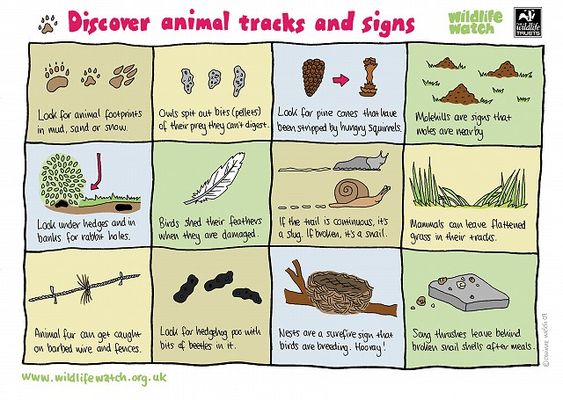
Watch for animal scat, trails, tracks, runways and other signs.
Tracks and other signs of animal passage will tell you a lot about wildlife behavior. They may also increase your chances of spotting the real thing. Mammals like deer, moose, foxes, and elk often create runways through the underbrush that identify the areas where they travel. Aquatic mammals like beavers and otters leave telltale signs near the water’s edge, including scat, lodges, dens, dams, flattened muddy trails, chewed wood, and even—in the case of otters—water slides.
After tracking a racoon for several hours one day, I learned that racoons, like humans, will take the path of least resistance through a forest. This includes walking across every fallen log within reach. You can increase your chances of spotting animal tracks, and often animals, by raking a sandy area next to a water source. Checking back usually reveals a highway of birds, rodents, and other mammals travelling to and fro. Raking a regular trail will help make the tracks more distinct and give a better idea of the track age. A general rule of thumb is that tracks are most easily spotted in areas covered by snow, mud, and sand.
Bring the right equipment.
A powerful pair of binoculars is a must-have for anyone interested in spotting wildlife up close. Not only do they protect you from potential encounters with large mammals, giving you the distance you need to stay safe, but they often allow you to observe wildlife unnoticed. Disturbed wildlife may be unable to feed or migrate safely, which may in turn disrupt their rate of survival. Keeping your distance while still getting an up-close look is one way to improve the experience for everyone.
To improve the experience still further, I use a spotting scope (20x to 60x). Although heavy when hiking long distances, the scope is worth the effort when viewing marine mammals like sea lions and whales from shore or watching far-off birds or wildlife interact and rear its young.
A zoom lens on a digital camera is also great, but a trail cam that can take time-lapsed photos and has a motion sensor trigger is a far more useful tool. If available, this tool can help you identify what kind of wildlife is using an area and when, so that you can focus your limited time more effectively. It will capture images that you could never get safely in person.
Stay still or move slowly and quietly.
Humans are large and smelly enough that most wildlife knows we are coming before we even get close to viewing them. One way around this is to get comfortable in a wildlife viewing area before dawn or dusk and sit patiently and quietly until they arrive. You can also climb a tree, mount a tree-sit, or hide yourself in shrubbery with the aid of camouflage (but not during hunting season!) or behind a hunting or viewing blind. Make sure you are downwind of your quarry and avoid bringing pets that might disturb wildlife by barking or running. However, a well-trained canine can alert you to wildlife long before you would suspect their presence.
If you do need to move when wildlife are present, do so from a distance, walking slowly and quietly. Watch the ground for branches or other debris that might alert them to your presence if stepped on. If you can, try spotting wildlife from a canoe or kayak: nothing is quite as stealthy as water travel.
Listen to the other wildlife in the area.
Wild animals interact daily, often with dramatic results. Over the years I’ve learned that a loud ruckus of crows or robins usually means a bird of prey is in the vicinity. Both robins and crows will mob owls on the hunt. Ravens and seagulls will do the same to eagles, who just might be relieved of any meat they are carrying.
In a similar way, birdsong and bird behavior will often change if predators like hawks are in the area, warning other birds to scatter or protect one another who share the same flock mentality. Frogs go silent when something approaches, so try paying attention to the changes around you.
Practice your animal
and bird calls.



